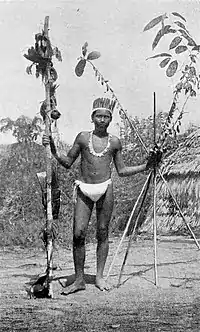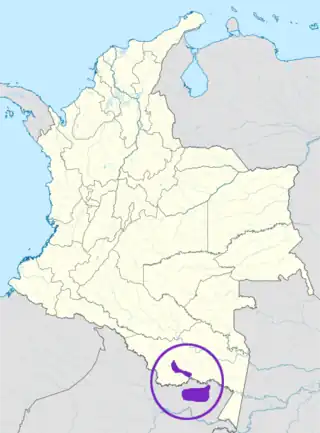Ocaina language
Ocaina is an indigenous American language spoken in western South America.
| Ocaina | |
|---|---|
| Xáfahxajoh | |
 An Ocaina chief in 1924. | |
| Native to | Peru, Colombia |
Native speakers | 55 (2000–2012)[1] |
Bora–Huitoto
| |
| Language codes | |
| ISO 639-3 | oca |
| Glottolog | ocai1244 |
| ELP | Ocaina |
 | |
Classification
Ocaina belongs to the Witotoan language family. It is its own group within the Huitoto-Ocaina sub-family.
Geographic distribution
Ocaina is spoken by 54 people in northeastern Peru and by 12 more in the Amazonas region of Colombia. Few children speak the language.
Dialects/Varieties
There are two dialects of Ocaina: Dukaiya and Ibo'tsa.
Phonology
Consonants
| Bilabial | Alveolar | Postalveolar/ Palatal |
Velar | Glottal | ||
|---|---|---|---|---|---|---|
| Nasal | lenis | m | n | ɲ | ||
| fortis | mː | nː | ɲː | |||
| Plosive | p b | t r | tʲ dʲ | k ɡ | ʔ | |
| Affricate | ts dz | tʃ dʒ | ||||
| Fricative | ɸ β | s | ʃ ʒ | x | h | |
Tone
Syllables in Ocaina may be marked with one of two tones: high or low.
Syllables
Syllables in Ocaina consist of a vowel; single consonants may appear on either side of the vowel: (C)V(C).
Writing system
Ocaina is written using a Latin alphabet. A chart of symbols with the sounds they represent is as follows:
| Latin | IPA |
|---|---|
| a | /a/ |
| b | /b/ |
| c | /k/ - /ts/ |
| ch | /tʃ/ |
| ds | /dz/ |
| dy | /dʲ/ |
| e | /e/ |
| f | /ɸ/ |
| g(u) | /ɡ/ - /h/ |
| h | /ʔ/ |
| i | /i/ |
| j | /h/ |
| k | /k/ |
| ll | /dʒ/ |
| m | /m/ |
| m̈ | /mː/ |
| n | /n/ |
| n̈ | /nː/ |
| ñ | /ɲ/ |
| ñ̈ | /ɲː/ |
| o | /o/ |
| p | /p/ |
| qu | /k/ |
| r | /r/ |
| s | /s/ |
| sh | /ʃ/ |
| t | /t/ |
| z | /ts/ |
| ty | /tʲ/ |
| u | /ɨ/ |
| v | /β/ |
| x | /x/ |
| y | /ʒ/ |
- Because the Ocaina alphabet is based on Spanish, c is used to indicate /k/ before a, o, and u, qu is used before e and i, and k is used in loan words, such as kerosene "kerosene".
- Nasalization is indicated by inserting n after a vowel. Compare: tya tyója [tʲa tʲóha] "hang it" vs. tya tyonjan [tʲa tʲṍhã] "clean it".
- High tone is indicated with the acute accent: á, é, í, ó, ú.
References
- Ocaina at Ethnologue (25th ed., 2022)

- Agnew, Arlene; Evelyn G. Pike (January 1957). "Phonemes of Ocaina (Huitoto)". International Journal of American Linguistics. 23 (1): 24–27. doi:10.1086/464385.
- Leach, Ilo M. (2008). Mary Ruth Wise (ed.). Vocabulario Ocaina (PDF). Serie Lingüística Peruana (in Spanish). Vol. 4 (2nd ed.). Yarinacocha, Peru: Instituto Lingüístico de Verano.
This article is issued from Wikipedia. The text is licensed under Creative Commons - Attribution - Sharealike. Additional terms may apply for the media files.